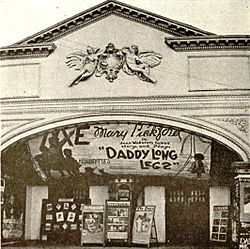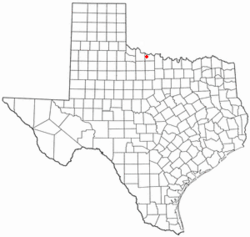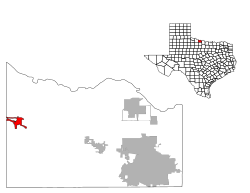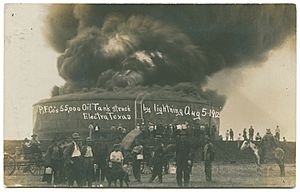Electra, Texas facts for kids
Quick facts for kids
Electra, Texas
|
|
|---|---|

Liberty Theater, Electra, showing a Mary Pickford movie in 1919.
|
|
| Motto(s):
"Wichita County's Best Kept Secret"
|
|

Location of Electra, Texas
|
|
 |
|
| Country | United States |
| State | Texas |
| County | Wichita |
| Area | |
| • Total | 3.08 sq mi (7.98 km2) |
| • Land | 3.08 sq mi (7.97 km2) |
| • Water | 0.00 sq mi (0.01 km2) |
| Elevation | 1,227 ft (374 m) |
| Population
(2020)
|
|
| • Total | 2,292 |
| • Density | 744.2/sq mi (287.22/km2) |
| Time zone | UTC-6 (Central (CST)) |
| • Summer (DST) | UTC-5 (CDT) |
| ZIP code |
76360
|
| Area code(s) | 940 |
| FIPS code | 48-22984 |
| GNIS feature ID | 2410419 |
Electra is a city in Wichita County, Texas, in the United States. It is part of the Wichita Falls metropolitan statistical area. In 2020, about 2,292 people lived there. This was a decrease from 2,791 people in 2010.
Electra is known as the "Pump Jack Capital of Texas." This title became official in 2001. The city has celebrated an annual Pump Jack Festival since 2002. The city was named after Electra Waggoner, who was an heiress to the famous Waggoner Ranch. Electra also has a Grand Theatre that has been fixed up and is now open.
Contents
History of Electra
The story of Electra began in 1852. That's when Daniel Waggoner started a ranch in the area where the city is today. About 30 years later, the Fort Worth and Denver Railway built railroad tracks through the ranch.
In 1885, Daniel's son, William Thomas Waggoner, convinced the railroad company to build a station there. At this time, the Waggoner ranch was huge, covering half a million acres. The town was first called Waggoner. But after the station and a post office were built in 1889, it was renamed Beaver Switch. This name came from the nearby Beaver Creek.
Later, 56,000 acres (about 227 square kilometers) of land north of the railroad station were opened up. This brought more farmers to the area. In 1907, the town was renamed again. This time, it was named Electra, after William Waggoner's daughter, Electra Waggoner.
Oil Discovery and Growth
Water was often hard to find in this part of Texas. So, Waggoner started drilling for water for the new residents. Many of these drilling attempts found crude oil instead of water. This made the water undrinkable.
Three years later, a developer from Fort Worth named Solomon Williams bought the land from Waggoner. He bought more land nearby and divided it into smaller pieces. He advertised across the country to get more people to move there. His efforts worked! The town's population grew from 500 to 1,000 people between 1907 and 1910. The Waggoner family still owns much of their original land and still drills for oil there today.
In 1911, the Electra Independent School District was started. This meant the town had its own schools.
On April 1, 1911, a big oil discovery happened. It was called the Clayco Oil gusher. Oil shot out from 1,600 feet (about 488 meters) deep. It produced 260 barrels of oil every day. News spread quickly, and the population grew to over 1,000. Many more oil workers came from Wichita Falls to work. Soon, Electra had brick buildings, cement sidewalks, and a telephone system.
In 1936, Electra had more than 6,000 residents. But by the 1960s, the population started to shrink to just over 5,000. Many people moved away as the Dallas-Fort Worth Metroplex grew. By 2000, Electra's population was about 3,000.
Geography and Climate
Electra is located in Texas. The city covers a total area of about 2.4 square miles (6.3 square kilometers). All of this area is land.
What is Electra's Climate Like?
The weather in Electra has hot and humid summers. The winters are usually mild to cool. According to the Köppen climate classification system, Electra has a humid subtropical climate. This means it has warm temperatures and plenty of rain.
Population Information
| Historical population | |||
|---|---|---|---|
| Census | Pop. | %± | |
| 1910 | 640 | — | |
| 1920 | 4,744 | 641.3% | |
| 1930 | 6,712 | 41.5% | |
| 1940 | 5,588 | −16.7% | |
| 1950 | 4,970 | −11.1% | |
| 1960 | 4,759 | −4.2% | |
| 1970 | 3,895 | −18.2% | |
| 1980 | 3,755 | −3.6% | |
| 1990 | 3,113 | −17.1% | |
| 2000 | 3,168 | 1.8% | |
| 2010 | 2,791 | −11.9% | |
| 2020 | 2,292 | −17.9% | |
| U.S. Decennial Census | |||
| Race | Number | Percentage |
|---|---|---|
| White (NH) | 1,722 | 75.13% |
| Black or African American (NH) | 114 | 4.97% |
| Native American or Alaska Native (NH) | 12 | 0.52% |
| Asian (NH) | 11 | 0.48% |
| Some Other Race (NH) | 5 | 0.22% |
| Mixed/Multi-Racial (NH) | 119 | 5.19% |
| Hispanic or Latino | 309 | 13.48% |
| Total | 2,292 |
In 2020, there were 2,292 people living in Electra. There were 1,253 households and 606 families.
Education in Electra
The Electra Independent School District serves the city of Electra. This school district covers an area of about 210 square miles (544 square kilometers).
There are three public schools in Electra:
- B.M. Dinsmore Elementary School: This school teaches students from prekindergarten through fourth grade.
- Electra Junior High: This school is for students in grades five through eight.
- Electra High School: This school teaches students from ninth through 12th grades. The sports teams at Electra High School are called the Tigers.
The number of students per teacher is small in Electra schools. This means teachers can give more attention to each student.
Famous People from Electra
Some notable people have connections to Electra:
- Stanley Kroenke: He is a very wealthy businessman who owns many sports teams. He is married into the Walton family, who started Walmart.
- Ace Reid: He was an artist and humorist. He grew up and lived in Electra until 1943, when he joined the Navy.
Utilities
Telephone and Internet services in Electra are provided by Hilliary Communications.
See also
 In Spanish: Electra (Texas) para niños
In Spanish: Electra (Texas) para niños


